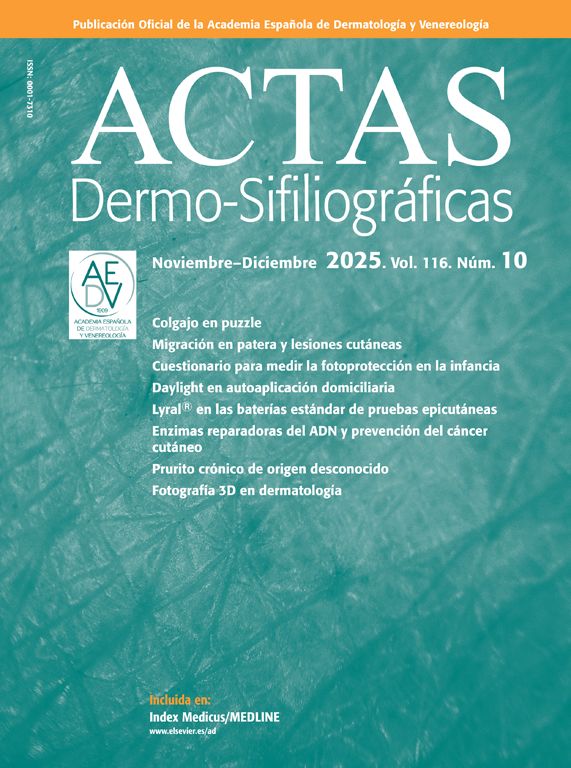According to Olavide, dermatoses could arise from a known cause – parasitic or “artificial” (external) – or be secondary due what the French dermatologic school of the time (Bazin, Hardy, among others) termed “constitutionalism.” These authors argued that disease was a “state of the person” as a whole, not of isolated body parts, and that the cutaneous lesion was not the disease itself but only its manifestation, except in parasitic dermatoses or those due to external causes.1
Within constitutional disorders of the skin, Olavide recognized rheumatic-type conditions, which Bazin had called “arthritides.”
Whereas proponents of these disorders attributed their etiopathogenesis to deposition of urea and other nitrogenous substances in tissues, Olavide considered them the result of two complementary processes: accumulation from overproduction and defective elimination of these organic products.
The objective of this paper is to highlight Olavide's comments on urticaria – one of these rheumatic constitutional dermatoses – in his work Aphorisms of Practical Dermatology (Fig. 1), published in 1880 by the Oficina Tipográfica del Hospicio de Madrid (Madrid, Spain).2 The general characteristics of this work have been summarized previously.3,4
CommentsOlavide defines urticaria as “a disease that disappears suddenly, leaving no trace, and that likewise reappears suddenly” (Aphorism 59). In this description we recognize wheals.
He warns that in some patients “urticaria may present in the mouth, pharynx, and epiglottis, giving rise to asphyctic phenomena due to swelling of this membranous veil. Fortunately, the glottic edema produced by urticaria is fleeting, and the patient returns to life without any remedy and sometimes so abruptly that it seems miraculous: this fact should not be overlooked, being prepared not only for diagnosis but also for prognosis and treatment” (Aphorism 245). He is describing angioedema.
Another of Olavide's clinical insights is the distinction between:
- -
Chronic urticaria, which “occurs repeatedly and persists for months or years, producing flares of varying duration each year; it depends on a constitutional cause (herpetism or rheumatism)”4 (Aphorism 237).
- -
Intermittent urticaria, which consists of “an intermittent fever with all its characteristics, giving rise to the eruption during one or all of its stages and which, as you know, responds readily to internal use of quinine” (Aphorism 246).
He further classifies urticarias into several groups based on potential triggers, clinical manifestations, and treatment response. For him there were:
- 1.
Rheumatic urticaria: “appears and worsens with cold and abrupt temperature changes; it is not very generalized, rather discrete and limited to a few body sites; its coloration is dark, violaceous, hemorrhagic, and the wheal is large, deep, firm, and nodular; it resembles erythema nodosum, though it is not painful like the latter. This urticaria itches intensely when undressing or getting out of bed or whenever the patient becomes chilled; its disappearance is slow (perstans), and it is cured by internal use of alkalies or tincture of iodine” (Aphorism 238). This likely corresponds to today's physical urticarias.
- 2.
Repercussed rheumatic urticaria: “commonly presents in the mouth, pharynx, and larynx, producing in their mucous membranes an erythematous, edematous engorgement so acute and abruptly formed that it leads to suffocation and may end in asphyxia. Bloodletting and widely applied mustard plasters are the urgent remedies for such a morbid state” (Aphorism 91). We recognize angioedema.
- 3.
Herpetic urticaria: “generalized, abrupt in onset and resolution, pink in color with irresistible pruritus, appears and worsens with atmospheric or bed heat; the deeper wheals are long, sinuous, mother-of-pearl white, and confluent (conferta); accompanied by neuralgias, neuroses, hysteralgias, and irritative uterine disorders; produced by nervous causes – frights, displeasures, and other moral causes; improves, though with difficulty, with continued arsenicals in increasing doses, and also requires narcotics and astringent baths” (Aphorism 239). Notably, Olavide already mentioned the relationship between acute urticaria and stress.
- 4.
Simple acute urticaria: “accompanied by moderate, fleeting fever, lasting a few days; intense red color; white wheals scattered over the body without confluence; resolves spontaneously with a light cooling diet intus (internally) and extra and, at most, a purgative. It is typical of spring, and in women may also depend on a menstrual disorder” (Aphorism 240). This could represent a cutaneous sign within the atopic spectrum.
- 5.
Urticaria ab ingestis: “depends on ingestion of certain surely altered foods, such as oily fish or shellfish, cod liver oil, etc. It begins with very high fever accompanied by frequent vomiting, delirium, and all the signs of severe indigestion or poisoning. It is very generalized: its erythema is extensive, generalized, red, and elevated; it does not disappear abruptly but only after two or three days or at least several hours, and then does not recur. Bloodletting is often used, but the best remedy is an emetic followed by acidulated or alkaline drinks” (Aphorism 241). Today we would speak of food poisoning.
- 6.
Artificial urticarias: “those provoked by nettle rubbing (Fig. 2), processionary hairs, or stings/bites of common parasites – louse, flea, bedbug, mosquito, etc. – as well as of certain flies, wasps, ants, and spiders; their distinguishing features are: (1) precise knowledge of the cause; (2) localization at the site of the insect bite or vegetal hair contact; (3) at the center of the wheal one finds the hair, the stinger, or a hole/depression indicating the exact point of the sting or bite; and (4) pruritus, intense at first, then subsiding until the gradual spontaneous disappearance of the wheal, which, although not slow, is not abrupt either” (Aphorism 242). These are recognized as local urticariform reactions.
As for pathogenesis, Olavide presciently forecast that “knowledge of the intimate nature of urticaria must come from organic chemistry: when it tells us what substance the nettle has or what septic poison certain parasitic insects inoculate to produce wheals in our body; when it clarifies the chemical alteration of oily fish – especially tuna – during spawning or breeding; when these morbid poisons are isolated, we shall experiment with them and also suspect that in cases of spontaneous urticaria or of internal cause, similar poisons are produced spontaneously in the blood, circulate through all capillaries, extravasate into the skin or mucosal tissues, exert their special effect, later break down, and are finally absorbed like the fluid of a hypodermic injection” (Aphorism 234). He adds, “it is probable that this irritant poison is free formic acid” (Aphorism 235). Today we know that histamine is one of the mediators responsible for urticaria.
Finally, Olavide offered remarks on treatments – now largely obsolete – prescribed to relieve the discomfort caused by these urticarial conditions (Table 1).
Aphorisms related to the treatment of urticaria.
| “Topicals that soothe the itching of urticaria include lotions with weak solutions of mineral acids or stronger solutions of organic acids (carbolic [phenic], acetic, tannic, etc.); alkaline baths or lotions (alkaline carbonates at 10 per 100 in water); camphorated alcohol; and soothing solutions of opium, morphine, chloroform, chloral, potassium bromide, and potassium cyanide.” (Aphorism 243)“The sedatives to be given at night to relieve the itching of chronic, constitutional urticaria should be potassium bromide first and, if this does not suffice, opium and chloral in adequate doses.” (Aphorism 244) |
From this description we may conclude:
- 1.
Olavide's aphorisms provide a historical document of late-19th century Spanish dermatology on the classification, clinical features, etiology, and therapeutics of one of the most frequent immunologic skin diseases in our practice.
- 2.
Although, in light of current knowledge, we cannot endorse all of his observations, the acuity with which Olavide develops these aphorisms on the clinical signs of urticaria is remarkable.
None declared.








